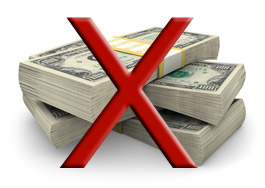
Top 10 lists are popular, so I couldn’t resist the urge - but since I’m positive these 10 aren’t the only 10 or necessarily the top 10, I decided to call this 10 Top Startup Killers. So stay tuned for 10 More Top Startup Killers 
Now down to business…
There are unfortunately many more ways to kill a startup than to make it succeed. The 10 below are some of the worst startup killers - violate these at your own risk.
Market Doesn’t Really Exist
So you were walking down the street, and inspiration struck - now you’re obsessed with the world’s greatest idea. Problem is - no one else thinks it’s a great idea; and it turns out - maybe it isn’t.
It’s always horrifying to me watching shows like “Shark Tank” and “American Inventor” and seeing people who’ve literally wiped out their life savings chasing an idea without ever validating whether a market existed for it. Validation isn’t always easy, but you absolutely must spend some energy determining whether there is a market and a need before investing huge resources building out an idea.
If you believe in the “Measure Twice, Cut Once” axiom, then now is a good time to “measure” the market.
“Nice to Have…” vs “Gotta Have!”
Although the “Market doesn’t exist” problem strikes many an entrepreneur, often terrible ideas are easy to stop in their tracks - especially if you have a loving spouse or trustworthy friend who’s willing to break the news to you before you waste too much energy on it.
The problem is, many ideas aren’t terrible, they’re “pretty good” - and these can be just as deadly.
When picking companies to invest in, VC’s try to determine whether your customer base deems your offering “nice to have” or “gotta have”. If it’s the latter, they will be interested, if it’s the former - they will run as fast as they can away from your idea. And maybe you should too.
The problem with “pretty good” ideas, is that prospects are more than willing to give you positive feedback until it’s time for them to take out their wallets. Or even worse - a small segment of prospects are willing to take out their wallets, but the mainstream will never care enough to pay to solve the problem.
Know whether your idea is “Gotta have”, or “Nice to have”.
Can’t profitably target your market
Even if a market exists, and even if they are willing to pay for your service; if it costs you more (or much more) to attract a customer than the customer is willing to pay you for your service, then you are in big trouble.
To determine if you can profitably target your market, you not only have to know where you can reach them (Internet locations, media, etc); you also need to know who you are competing with for the customer’s attention. I.e., you aren’t just competing with the “competitors” you envision who offer your service to the same customers - you are also competing with other companies who are trying to gain the attention of those very same customers.
If you can target your market cost effectively, you can win. If you can’t - then it doesn’t matter if they “need” your product, you simply won’t be able to attract enough customers without running out of cash.
Lack of Development Horsepower
If we take a simplistic view of a startup company (and especially a web company), then it is safe to say the company needs development (geeks) and sales (suits) to succeed. To argue which of these two is more “strategic” or critical to succeed is to miss the real answer. If either is lacking, your startup is destined to fail no matter how stellar the other side is.
The developer or development team (although if you’re a startup, chances are the “team” should start out as 1 person) needs to be the “A Team”. They should be passionately excited about the product; they should understand the business objectives; and - oh yeah - they should be good at developing (and you should keep in mind that ~80% of developers are not good at development).
If you have the world’s greatest salesman, and the real pulse on the business potential - and then you hire the B, C, or D team to develop your product; you are all but guaranteed to fail, unless your vision of the startup doesn’t go beyond a “pitch deck”.
Lack of Sales Horsepower
Equally frustrating to “Lack of Development Horsepower” is lack of sales horsepower. You can have a great market, and a killer product - but if your sales person / team lacks the chops to get it sold, you are in for a world of hurt. Your killer product will die on the vine, and you will constantly hear the sales team saying “if only it had x feature, it would sell like crazy.”
In the ideal world, your product will be ultra-viral like Facebook, and you won’t need any sales people to spread the word - but for the 99.999% rest of us - if sales is a factor in connecting to your market, you absolutely must make sure the sales team can sell.
No Plan
Like a game of chess (from what I’ve heard, I’ve never actually played  ), you need to think several moves ahead when you are launching your startup. If you are only gunning for the next milestone without thinking about what will come after that, you could end up hitting the milestone only to find out that you can’t go on because you ran out of resources from lack of planning.
), you need to think several moves ahead when you are launching your startup. If you are only gunning for the next milestone without thinking about what will come after that, you could end up hitting the milestone only to find out that you can’t go on because you ran out of resources from lack of planning.
It’s a cliche - but business plans (the kind that you actually use to run your business) are critical.
Planning to Plan
The opposite of no business plan can be equally deadly and costly. Many entrepreneurs spend weeks, months, (or years even) perfecting a business plan without ever working on their business, exhausting all of their resources in the process.
If you want to be a writer, be a writer - don’t start a company. Business plans are useful, but businesses are more useful. Make sure you spend the vast majority of your time actually building the business, not “planning to plan”.
Chasing VC Dollars instead of Customer Dollars
Often the biggest driver for the “planning to plan” crowd is the dream of VC dollars coming in to make everyone rich as the company goes through the roof (or in the later stages of planning to plan, the dream is the VC dollars coming in to save the day).
Here’s how it actually works.
If you can’t convince customers to give you their dollars, don’t waste your time pitching VC’s about how if only you had their money you could sell customers. They don’t want to hear it. For the vast majority of deals, customer revenue MUST come first, then (maybe) VC revenue (might) come later.
Premature Ramp-up - or hiring “just in case”
In the world of “if we don’t build version 15 immediately, some huge competitor is going to eat our lunch”, it is easy to get caught up in the pressure to build out a huge development team to handle the influx of “imminent sales”.
The problem is - whenever this is done, the only thing that ends up being “imminent” is the constant onslaught of developer salaries. I’ve seen too many companies that actually could have organically found their path and grown into great companies - but they ramped up too early, got stuck with a devastating burn rate - and ran out of cash.
A better strategy - keep your development team as light as possible (remember: A team only), and only ramp development capacity when sales justify the need.
Confusing a Pitch with a Product
You might have a huge idea, a powerful set of slides, and a sheet of numbers that show how easy it will be to scale into the billions of dollars in revenue.
But if you don’t have a product (or a “Beta product” as I’ve written in previous posts), don’t kid yourself - you only have a pitch.
I’ve seen way way way way WAY too many entrepreneurs tell me about a great idea and get me excited about a great pitch; only to return 6 months later to tell me about their great pitch.
If your pitch is really so great (and thus the product you are pitching is such a great idea), then first “buy it yourself” and build the thing already! 
 Don’t Need it.
Don’t Need it. Despite how applicable the goose / golden egg metaphor is to startups - there is a distinct lack of goose related articles in entrepeneurial writings, so with this post I’m going to try and pick up the slack
Despite how applicable the goose / golden egg metaphor is to startups - there is a distinct lack of goose related articles in entrepeneurial writings, so with this post I’m going to try and pick up the slack  Business plans - at their best - are an invaluable tool to help a small startup or growing company plot its path to the next stage of growth.
Business plans - at their best - are an invaluable tool to help a small startup or growing company plot its path to the next stage of growth. While millions of entrepreneurs are busy building the country’s future, very few of them are given any direction on “what not to do” - and thus they must learn the hard lessons of launching a venture first-hand.
While millions of entrepreneurs are busy building the country’s future, very few of them are given any direction on “what not to do” - and thus they must learn the hard lessons of launching a venture first-hand.

 We’ve all heard that we need to get our “ducks in a row” if we want to succeed as entrepreneurs. This is certainly true, but…
We’ve all heard that we need to get our “ducks in a row” if we want to succeed as entrepreneurs. This is certainly true, but… One of the funniest scenes in the 1999 movie classic “Office Space” happens when Tom Smykowski lets Peter, Samir and Michael in on his great idea for the “Jump to Conclusions Mat” - which is a “mat, with a whole bunch of conclusions on it, … that you jump to!”
One of the funniest scenes in the 1999 movie classic “Office Space” happens when Tom Smykowski lets Peter, Samir and Michael in on his great idea for the “Jump to Conclusions Mat” - which is a “mat, with a whole bunch of conclusions on it, … that you jump to!”